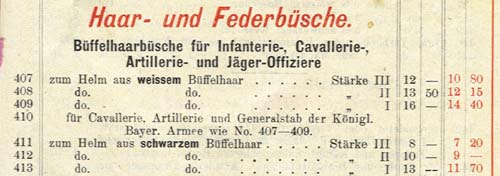Parade Plumes
Joseph P. Robinson.
15 November 2005.
Not a great deal has been written about the individual plumes used on pickelhaube. Randy Trawnik, in his new volume “Spiked Helmets of Imperial Germany” devotes an entire chapter to parade plumes. This short article is intended to augment the information in that volume. The book shows many pictures of helmets with parade plumes. This article will focus on pictures from the timeframe. There is no intent to discuss the feathered plumes of generals, nor the plumes on Ulan, Hussars or shakos.
Plumes came in three colors: red, white and black the same colors as a national flag.



These were not standard throughout however, as in general the first two battalions of guard regiments wore white plumes and the third battalion black plumes. Red was reserved for musicians, but also for certain Bavarian artillery. The general rule of thumb was that white was more elite.
The first generalization to ensure we look at is that not all regiments wore plumes. Only those authorized to wear plumes wore them. As a result, many helmets have spikes that do not unscrew to allow a trichter. Many private purchase helmets that were used in regiments that were not allowed plumes still had spikes that unscrewed. This was an inexpensive upgrade and aided in the transportation of the helmet. For some reason there is a legend that says only officers wore plumes; this is absolutely false. The real purpose of the plumes was for parade, those that did not parade, like a zahlmeister, did not wear a plume.
The second generalization is that enlisted soldiers wore horsehair plumes, and officers wore fuzzy buffalo plumes. In reality the plumes were first authorized in 1843. The trichter shape and size changed, and both officers and enlisted personnel wore straight horsehair plumes until 1896. There was a separation of commissioned officer, plumes in that year by allowing the wearing of a buffalo plume instead of a horsehair plume. Horsehair was easy to spot. Straight and kind of scraggly whereas the buffalo plume was more curly or kinky and more full. The buffalo hair came from a yak.



According to regulation of the officer trichter was supposed to be 15 cm long supplanted by a 4.5 cm button on top. There were many different styles of trichters and buttons. Those pictured below are a mere subset.






Another part of the regulation was that the plume itself would be trimmed with a pair of scissors. For troops on foot, the intent was to cut it to the top edge of the front visor. Mounted troops were supposed to have the plume cut to the bottom edge of the front visor. Photographic evidence shows that sometimes it is not easy to determine if length was applied properly.
The man on the left from the 92nd Regiment is cut properly for foot to the top of the visor. The gentleman in the center is from a mounted unit, and you can see how much longer his plume is. The photo on the right below it is of a foot unit, but you cannot tell that on the basis of the plume length alone.



The plume was to be cut to the wearing length regardless of the length of the trichter. Trichters did not always start off that 15 cm and older trichters were shorter as the helmets themselves were taller. Trichters “grew” as helmet size decreased.


Differences in the quality of the plume are easily described in the catalog by M.Neumann. Similar to helmets themselves, the plumes came in different qualities. The higher the quality, the fuller the plume was, and the higher the cost was. It is interesting to note that a white plume could cost as much as 50% more than a black plume.

Enlisted helmets came with issued plumes. However, you could also buy one that was in enlisted quality. It is instructive that these came in two qualities. The lower quality was horsehair and the higher-quality was hair from the horse’s mane. As opposed to buffalo hair these were extremely cheap. You can also see on the bottom of the chart that you could get an extra light trichter for a substantial increase in cost.

The 1903 enlisted uniform regulation specifies that the enlisted trichter is somewhat shorter 11 cm high. The button on top is somewhat smaller, and the design on top is plain. Private purchase trichters tended to be shaped like a spike with the plume on top. The issue trichters, looked more like a tube.


As with many items in the enlisted regulation, the weight of the parade plume was very important.

Again, this is only a beginning to supplement the information already available.
Pictures come from the author’s archive, the Kostel collection or with permission of the owner. Translation assistance from Roger Benner. Catalog is price list 29 from Neumann undated. The enlisted uniform rate is a 1903 version printed by Mittler and son.

